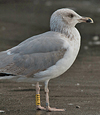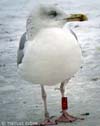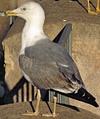 Yellow-legged
Gull - Larus michahellis
Yellow-legged
Gull - Larus michahellis
(last update: October 08 2013)
Coordinators:
Delfín González
Gabriel Martín
Antonio Gutierrez
Amir Ben Dov
Mars Muusse
Larus michahellis - 4CY / sub-adult January
This website deals with the Yellow-legged Gull taxon michahellis, which is a common migrant from July to December in NW Europe. After extensive expansion of the breeding population during the last three decades, it nowadays can be found breeding in Belgium, the Netherlands and Britain in mixed couples with both Herring Gull (argenteus) and Lesser Black-backed Gull (graellsii). There are subtle differences between the populations from the Mediterranean, Atlantic coast of Portugal and Morocco and from the islands in the Atlantic. Most pronounced differences can be found in the taxon atlantis, now regarded as full species by some authors and birds along the Atlantic coast of the Iberian peninsular: lusitanius. Both atlantis and lusitanius are treated in their own sections on this website.
General description
Sub-adult michahellis (in 4CY and 5CY) may resemble birds in adult plumage. On average, 4CY birds normally still show a few immature features, but on the other hand some 4CY match the average adult very well and are hard to identify. Nevertheless, some of the following characteristics can often be found in 4CY birds:
- The bill is not saturated orangey-yellow, but pale yellow, especially towards the very tip and the base of the bill.
- The bill often has obvious black marks on the upper and lower mandible near the gonydeal angle.
- The red spot on the gonydeal angle doesn't reach the cutting edge of the lower mandible. In older birds this red spot extends on the upper mandible.
- The iris is peppered or speckled, unlike the plain yellow iris in most older birds (5+cy birds).
- Some old wing-coverts have a brown hue, especially visible in the outer lesser coverts or central greater coverts.
- The central and lower tertials and outer secondaries show patterns commonly found in third generation feathers: the tertials have dark centres with vermiculate spaghetti pattern towards the fringes and the outer secondaries show a brown hue on the centres, unlike the plain grey fourth generation secondaries found in 5CY and older michahellis.
- The primary coverts show an all-dark brownish centre with a small paler crescent on the tip. In older birds these primary coverts are all grey or at least show a grey base with sometimes some black (an accentuated shaft). Black in the primary coverts in 5+cy birds is often related to the size of the black on the primaries, which may "extend" on the primary coverts.
- The white tip on P10 doesn't merge with the mirror but is separated by a broad sub-terminal band and even P5 shows a broad black patch. In older birds the black sub-terminal band on P10 is much narrower and the white mirror on P10 broader. The tips on fresh primaries are larger in adult birds.
- The tail may show small black spots on the tail-feathers.
As can be expected, there is no surprising moult going on in sub-adult birds, this time of the year. The average adult michahellis finishes primary moult by the end of October. By January, the outer primaries may show slight wear already. The winter head streaking, which was obvious and concentrated on the ear-coverts, around the eye and up to the crown by September and October, has been worn away by mid winter, leaving the snow white appearance as in adult michahellis.
For details on differences between michahellis and cachinnans, see e.g. the article by R. Klein & D. Gruber in Limicola, April 1997.
michahellis at Le Portel, NW France:
Le Portel and the near surrounding do not hold large colonies of Yellow-legged Gulls. Numbers of sub-adult Yellow-legged Gulls in NW France are low in winter. At the landfill of Dannes, near Le Portel, large mixed flocks of mainly Herring Gulls (1,000's) from NW and N Europe can be found including adult and sub-adult Yellow-legged Gulls (few tens in January 2002). By March, many adult Yellow-legged Gulls and with them the near adults return to the breeding grounds. The breeding season starts early for this species which breeds in southern Europe.
 Yellow-legged Gull michahellis 3CY-4CY I357 February 2005 & January 2006, Switzerland. Picture: Stephane Aubry.
Yellow-legged Gull michahellis 3CY-4CY I357 February 2005 & January 2006, Switzerland. Picture: Stephane Aubry.
 Yellow-legged Gull lusitanius A:2SX 4CY, January 14 2015, Leixões harbor - Matosinhos, Portugal. Picture: José Marques.
Yellow-legged Gull lusitanius A:2SX 4CY, January 14 2015, Leixões harbor - Matosinhos, Portugal. Picture: José Marques. Yellow-legged Gull lusitanius ZR5B 4CY, January 25 & February 01 2015, Angeiras beach, Matosinhos, Portugal. Picture: José Marques.
Yellow-legged Gull lusitanius ZR5B 4CY, January 25 & February 01 2015, Angeiras beach, Matosinhos, Portugal. Picture: José Marques. Yellow-legged Gull lusitanius POL M024132 sub-adult, January 14 2015, Leixões harbor - Matosinhos, Portugal. Picture: José Marques.
Yellow-legged Gull lusitanius POL M024132 sub-adult, January 14 2015, Leixões harbor - Matosinhos, Portugal. Picture: José Marques. Yellow-legged Gull michahellis 4CY HES M015057 January 13 2006, Portalban, Switzerland. Picture: Stephane Aubry.
Yellow-legged Gull michahellis 4CY HES M015057 January 13 2006, Portalban, Switzerland. Picture: Stephane Aubry. Yellow-legged Gull michahellis 4CY SR63 January 26 2008, Molfetta, Bari, Italy (41.12 N 16.36 E).
Picture: A. Nitti.
Yellow-legged Gull michahellis 4CY SR63 January 26 2008, Molfetta, Bari, Italy (41.12 N 16.36 E).
Picture: A. Nitti. Yellow-legged Gull michahellis sub-adult 672H January 17 2013, Witoszówka Reservoir, Swidnica, Poland. Picture: Mariusz Dabek.
Yellow-legged Gull michahellis sub-adult 672H January 17 2013, Witoszówka Reservoir, Swidnica, Poland. Picture: Mariusz Dabek. Yellow-legged Gull michahellis 720H 4CY, January 25 2015, Fori Imperiali - Rome, Italy. Picture: Dirk van Gansberghe.
Yellow-legged Gull michahellis 720H 4CY, January 25 2015, Fori Imperiali - Rome, Italy. Picture: Dirk van Gansberghe. Yellow-legged
Gull michahellis sub-adult, January 02 2011, Mamaia, Romania. Picture: Chris Gibbins.
Yellow-legged
Gull michahellis sub-adult, January 02 2011, Mamaia, Romania. Picture: Chris Gibbins. Yellow-legged Gull michahellis 4CY, January 25 2015, Fori Imperiali - Rome, Italy. Picture: Dirk van Gansberghe.
Yellow-legged Gull michahellis 4CY, January 25 2015, Fori Imperiali - Rome, Italy. Picture: Dirk van Gansberghe. Yellow-legged Gull michahellis 4CY, January 12 2015, Fori Imperiali - Rome, Italy. Picture: Dirk van Gansberghe.
Yellow-legged Gull michahellis 4CY, January 12 2015, Fori Imperiali - Rome, Italy. Picture: Dirk van Gansberghe. Yellow-legged Gull michahellis sub-adult, January 12 2015, Fori Imperiali - Rome, Italy. Picture: Dirk van Gansberghe.
Yellow-legged Gull michahellis sub-adult, January 12 2015, Fori Imperiali - Rome, Italy. Picture: Dirk van Gansberghe.